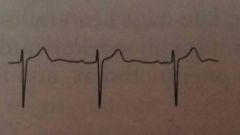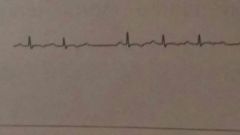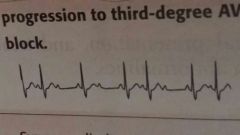![]()
![]()
![]()
Use LEFT and RIGHT arrow keys to navigate between flashcards;
Use UP and DOWN arrow keys to flip the card;
H to show hint;
A reads text to speech;
25 Cards in this Set
- Front
- Back
- 3rd side (hint)
|
What is sinus bradycardia |
Normal response to cardiovascular conditioning, can also result from sinus node dysfunction, or from beta blocker or calcium channel blocker excess |
|
|
|
What are the signs and symptoms of sinus bradycardia? |
Can be asymptomatic lightheadedness syncope, chest pain, hypotension |
|
|
|
Sinus bradycardia ECG findings |

Ventricular rate less than 60 BPM |
|
|
|
Sinus bradycardia treatment |
Asymptomatic--don't treat Atropine to increase heart rate Definitive treatment pacemaker - if severe |
|
|

PR interval > 200 msec |
First degree AV block |
|
|
|
Reasons for a first degree AV block |
Increased vagal tone
beta blocker or CCB use
can occur in normal individuals
No treatment necessary |
|
|

Second degree AV block or Mobitz type 1 Wenckebach |
Progressive PR lengthening until a dropped beat occurs then the PR interval resets |
|
|
|
Why does a second degree AV block mobitz 1 wenkenbach occur? |
Second degree AV block type 1 occurs due to drug effects like dioxin, beta blocker, CCB or an increased vagal tone, right coronary ischemia or infarction |
|
|
|
Treatment for second degree AV block mobitz 1 |
Stop the offending drug! Atropine as clinically indicated |
|
|

Mobitz type 2 or second degree AV block |
Occasional syncope frequent Progression to third degree AV block |
|
|
|
, what does a second degree AV block mobitz type 2 look like on ECG |
Unexpected dropped beat without a change in PR interval |
|
|
|
What is the treatment for mobitz type 2 or second degree AV block |
Pacemaker placement |
|
|

Third degree AV block complete |
New electrical communication between the Atria and ventricles |
|
|
|
What are the symptoms or signs of third degree AV block complete? |
Syncope, dizziness, acute heart failure, hypertension, Cannon a waves |
No relationship between p waves and QRS complexes |
|
|
What is the treatment for 3rd degree AV block complete? |
Pacemaker placement |
|
|
|
What is sick sinus syndrome |
A heterogeneous disorder that leads to intermittent supraventricular tachy and brady arrhythmias. |
Also known as tachycardia bradycardia syndrome |
|
|
What are the symptoms and signs of sick sinus syndrome? |
Secondary to tachycardia or bradycardia may include syncope, palpitations, dyspnea, chest pain, CIA, and stroke. |
|
|
|
Treatment for sick sinus syndrome |
Sick sinus syndrome most common indication for a pacemaker placement |
|
|
|
Congestive heart failure CHF |
Clinical syndrome caused by inability of the heart to pump enough blood to maintain fluid and metabolic hemostasis. |
|
|
|
Risk factors for CHF |
Coronary artery disease, hypertension, cardiomyopathy, valvular heart disease, diabetes |
|
|
|
What is the most common cause of right sided heart failure? |
Left-sided heart failure |
|
|
|
Drug options for atrial fibrillation |
ABCD**
**Think ABCD*** *ANTICOAGULATE *B blockers to control rate *Cardioversion or calcium channel blockers *digoxin |
|
|
|
Systolic dysfunction |
Decreased ejection fraction less than 50% and increased left ventricular end-diastolic volume
Left ventricle is not Contracting well or increased afterload |
|
|
|
How does the heart compensate during systolic dysfunction? |
decreased ejection fraction and increased preload and afterload causes the heart to hypertrophy and the ventricles will dilate *but this will ultimately fail because of increased myocardial work and worsening systolic function. |
|
|
|
Cardiac heart failure symptoms |
Earliest sign===dyspnea on exertion
Chronic cough fatigue peripheral edema nocturia abdominal fullness orthopnea paroxysmal nocturnal dyspnea rest dyspnea |
|

